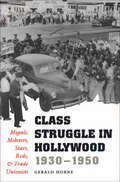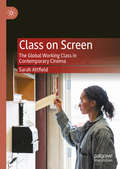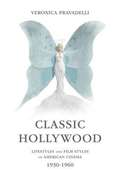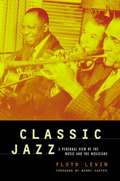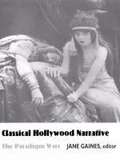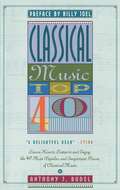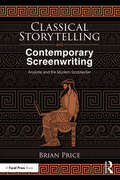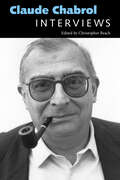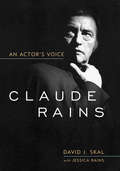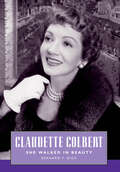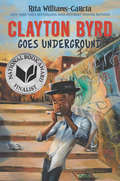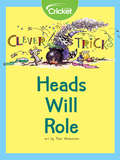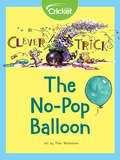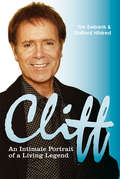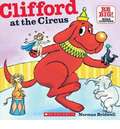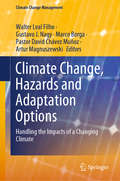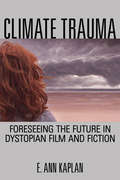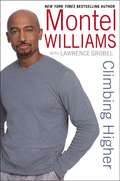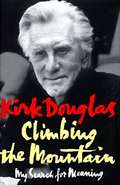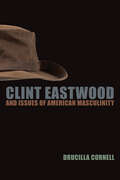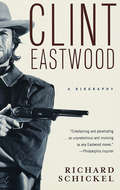- Table View
- List View
Class Struggle in Hollywood, 1930-1950: Moguls, Mobsters, Stars, Reds, & Trade Unionists
by Gerald HorneAs World War II wound down in 1945 and the cold war heated up, the skilled trades that made up the Conference of Studio Unions (CSU) began a tumultuous strike at the major Hollywood studios. This turmoil escalated further when the studios retaliated by locking out CSU in 1946. This labor unrest unleashed a fury of Red-baiting that allowed studio moguls to crush the union and seize control of the production process, with far-reaching consequences. This engrossing book probes the motives and actions of all the players to reveal the full story of the CSU strike and the resulting lockout of 1946. Gerald Horne draws extensively on primary materials and oral histories to document how limited a "threat" the Communist party actually posed in Hollywood, even as studio moguls successfully used the Red scare to undermine union clout, prevent film stars from supporting labor, and prove the moguls' own patriotism.
Class Struggle in Hollywood, 1930–1950: Moguls, Mobsters, Stars, Reds, & Trade Unionists
by Gerald Horne&“A taut narrative in elegant prose . . . Horne has unearthed a vitally important and mostly forgotten aspect of Hollywood and labor history.&” —Publishers Weekly As World War II wound down in 1945 and the cold war heated up, the skilled trades that made up the Conference of Studio Unions (CSU) began a tumultuous strike at the major Hollywood studios. This turmoil escalated further when the studios retaliated by locking out CSU in 1946. This labor unrest unleashed a fury of Red-baiting that allowed studio moguls to crush the union and seize control of the production process, with far-reaching consequences. This engrossing book probes the motives and actions of all the players to reveal the full story of the CSU strike and the resulting lockout of 1946. Gerald Horne draws extensively on primary materials and oral histories to document how limited a &“threat&” the Communist party actually posed in Hollywood, even as studio moguls successfully used the Red scare to undermine union clout, prevent film stars from supporting labor, and prove the moguls&’ own patriotism. Horne also discloses that, unnoticed amid the turmoil, organized crime entrenched itself in management and labor, gaining considerable control over both the &“product&” and the profits of Hollywood. This research demonstrates that the CSU strike and lockout were a pivotal moment in Hollywood history, with consequences for everything from production values, to the kinds of stories told in films, to permanent shifts in the centers of power.
Class on Screen: The Global Working Class in Contemporary Cinema
by Sarah AttfieldThis book provides an analysis of the global working class on film and considers the ways in which working-class experience is represented in film around the world. The book argues that representation is important because it shapes the way people understand working-class experience and can either reinforce or challenge stereotypical depictions. Film can shape and shift discussions of class, and this book provides an interdisciplinary study of the ways in which working-class experience is portrayed through this medium. It analyses the impact of contemporary films such as Sorry To Bother You, This is England and Le Harve that focus on working class life. Attfield demonstrates that the global working class are characterised by diversity of race, ethnicity, gender, religion and sexuality but that there are commonalities of experience despite geographical distance and cultural difference. The book is structured around themes such as work, culture, diasporas, gender and sexuality, and race.
Class, Crime and International Film Noir
by Dennis BroeClass, Crime and International Film Noir argues that, in its postwar, classical phase, this dark variant of the crime film was not just an American phenomenon. Rather, these seedy tales with their doomed heroes and heroines were popular all over the world including France, Britain, Italy and Japan.
Classic Hollywood: Lifestyles and Film Styles of American Cinema, 1930-1960
by Michael Meadows Veronica PravadelliStudies of "Classic Hollywood" typically treat Hollywood films released from 1930 to 1960 as a single interpretive mass. Veronica Pravadelli complicates this idea. Focusing on dominant tendencies in box office hits and Oscar-recognized classics, she breaks down the so-called classic period into six distinct phases that follow Hollywood's amazingly diverse offerings from the emancipated females of the "Transition Era" and the traditional men and women of the conservative 1930s that replaced it to the fantastical Fifties movie musicals that arose after anti-classic genres like film noir and women's films. Pravadelli sets her analysis apart by paying particular attention to the gendered desires and identities exemplified in the films. Availing herself of the significant advances in film theory and modernity studies that have taken place since similar surveys first saw publication, she views Hollywood through strategies as varied as close textural analysis, feminism, psychoanalysis, film style and study of cinematic imagery, revealing the inconsistencies and antithetical traits lurking beneath Classic Hollywood's supposed transparency.
Classic Jazz: A Personal View of the Music and the Musicians
by Floyd LevinAn award-winning jazz writer has pulled together 50 years' worth of his articles, which appeared mostly in jazz magazines, to take readers into the world of jazz and its musicians. This personal view of a rich American music weaves in anecdotal material, primary research, and music analysis into every chapter. 51 photos. 10 line illustrations.
Classical Hollywood Narrative: The Paradigm Wars
by Jane M. GainesSince the 1970s film studies has been dominated by a basic paradigm--the concept of classical Hollywood cinema--that is, the protagonist-driven narrative, valued for the way it achieves closure by neatly answering all of the enigmas it raises. It has been held to be a form so powerful that its aesthetic devices reinforce gender positions in society. In a variety of ways, the essays collected here--representing the work of some of the most innovative theorists writing today--challenge this paradigm.Significantly expanded from a special issue of South Atlantic Quarterly (Spring 1989), these essays confront the extent to which formalism has continued to dominate film theory, reexamine the role of melodrama in cinematic development, revise notions of "patriarchal cinema," and assert the importance of television and video to cinema studies. A range of topics are discussed, from the films of D. W. Griffith to sexuality in avant-garde film to television's Dynasty.Contributors. Rick Altman, Richard Dienst, Jane Feuer, Jane Gaines, Christine Gledhill, Miriam Hansen, Norman N. Holland, Fredric Jameson, Bill Nichols, Janey Staiger, Chris Straayer, John O. Thompson
Classical Music Top 40
by Anthony RudelIn this informal and informative guide, Rudel leads listeners through the 40 most essential and popular compositions from the Four Seasons to Rhapsody in Blue, explaining the musical structure of each passage and highlighting special themes or elements to listen for as the music continues.
Classical Storytelling and Contemporary Screenwriting: Aristotle and the Modern Scriptwriter
by Brian PriceSince we first arrived on the planet, we’ve been telling each other stories, whether of that morning’s great saber-tooth tiger hunt or the latest installment of the Star Wars saga. And throughout our history, despite differences of geography or culture, we’ve been telling those stories in essentially the same way. Why? Because there is a RIGHT way to tell a story, one built into our very DNA. In his seminal work Poetics, Aristotle identified the patterns and recurring elements that existed in the successful dramas of his time as he explored precisely why we tell stories, what makes a good one, and how to best tell them. In Classical Storytelling and Contemporary Screenwriting, Brian Price examines Aristotle’s conclusions in an entertaining and accessible way and then applies those guiding principles to the most modern of storytelling mediums, going from idea to story to structure to outline to final pages and beyond, covering every relevant screenwriting topic along the way. The result is a fresh new approach to the craft of screenwriting—one that’s only been around a scant 2,500 years or so—ideal for students and aspiring screenwriters who want a comprehensive step-by-step guide to writing a successful screenplay the way the pros do it.
Classical Traditions In Science Fiction
by Benjamin Eldon Stevens Brett M. Rogersor all its concern with change in the present and future, science fiction is deeply rooted in the past and, surprisingly, engages especially deeply with the ancient world. Indeed, both as an area in which the meaning of "classics" is actively transformed and as an open-ended set of texts whose own 'classic' status is a matter of ongoing debate, science fiction reveals much about the roles played by ancient classics in modern times. Classical Traditions in Science Fiction is the first collection in English dedicated to the study of science fiction as a site of classical receptions, offering a much-needed mapping of that important cultural and intellectual terrain.
Claude Chabrol: Interviews (Conversations with Filmmakers Series)
by Christopher BeachClaude Chabrol (1930–2010) was a founding member of the French New Wave, the group of filmmakers that revolutionized French filmmaking in the late 1950s and early 1960s. One of the most prolific directors of his generation, Chabrol averaged more than one film per year from 1958 until his death in 2010. Among his most influential films, Le Beau Serge, Les Cousins, and Les Bonnes Femmes established his central place within the New Wave canon. In contrast to other filmmakers of the New Wave such as Jean-Luc Godard and Eric Rohmer, Chabrol exhibited simultaneously a desire to create films as works of art and an impulse to produce work that would be commercially successful and accessible to a popular audience. The seventeen interviews in this volume, most of which have been translated into English for the first time, offer new insights into Chabrol’s remarkably wide-ranging filmography, providing a sense of his attitudes and ideas about a number of subjects. Chabrol shares anecdotes about his work with such actors as Isabelle Huppert, Gérard Depardieu, and Jean Yanne, and offers fresh perspectives on other directors including Jean-Luc Godard, Fritz Lang, and Alfred Hitchcock. His mistrust of conventional wisdom often leads him to make pronouncements intended as much to shock as to elucidate, and he frequently questions established ideas and normative attitudes toward moral, ethical, and social behaviors. Chabrol’s intelligence is far-reaching, moving freely between philosophy, politics, psychology, literature, and history, and his iconoclastic spirit, combined with his blend of sarcasm and self-deprecating humor, gives his interviews a tone that hovers between a high moral seriousness and a cynical sense of hilarity in the face of the world’s complexities.
Claude Rains: An Actor's Voice (Screen Classics)
by David J. Skal Jessica RainsLate in Claude Rains's distinguished career, a reverent film journalist wrote that Rains "was as much a cinematic institution as the medium itself." In Claude Rains: An Actor's Voice, noted Hollywood historian David J. Skal draws on more than thirty hours of newly-released Rains interviews to create the first full-length biography of the actor nominated multiple times for an Academy Award for Best Supporting Actor. This portrait of a universally respected Hollywood legend also benefits from the insights of his daughter, Jessica Rains, who provides firsthand accounts of the enigmatic man behind her father's refined screen presence and genteel public persona. With unprecedented access to episodes from Rains's private life, Skal tells the full story of the consummate character actor of his generation.
Claudette Colbert: She Walked in Beauty (Hollywood Legends Series)
by Bernard F. DickClaudette Colbert's mixture of beauty, sophistication, wit, and vivacity quickly made her one of the film industry's most famous and highest-paid stars of the 1930s and 1940s. Though she began her career on the New York stage, she was beloved for her roles in such films as Preston Sturges's The Palm Beach Story, Cecil B. DeMille's Cleopatra, and Frank Capra's It Happened One Night, for which she won an Academy Award. She showed remarkable prescience by becoming one of the first Hollywood stars to embrace television, and she also returned to Broadway in her later career. This is the first major biography of Colbert (1903–1996) published in over twenty years. Bernard F. Dick chronicles Colbert's long career, but also explores her early life in Paris and New York. Along with discussing how she left her mark on Broadway, Hollywood, radio, and television, the book explores Colbert's lifelong interests in painting, fashion design, and commercial art. Using correspondence, interviews, periodicals, film archives, and other research materials, the biography reveals a smart, talented actress who conquered Hollywood and remains one of America's most captivating screen icons.
Clayton Byrd Goes Underground
by Rita Williams-Garcia<P>Clayton feels most alive when he’s with his grandfather, Cool Papa Byrd, and the band of Bluesmen—he can’t wait to join them, just as soon as he has a blues song of his own. But then the unthinkable happens. Cool Papa Byrd dies, and Clayton’s mother forbids Clayton from playing the blues. And Clayton knows that’s no way to live. <P>Armed with his grandfather’s brown porkpie hat and his harmonica, he runs away from home in search of the Bluesmen, hoping he can join them on the road. But on the journey that takes him through the New York City subways and to Washington Square Park, Clayton learns some things that surprise him. <P>From beloved Newbery Honor winner and three-time Coretta Scott King Award winner Rita Williams-Garcia comes a powerful and heartfelt novel about loss, family, and love that will appeal to fans of Jason Reynolds and Kwame Alexander.
Clever Tricks: Heads Will Role
by Liz HuyckTwo coins are face-up side by side. What will happen if you roll one coin around the top of the other? Will the head be right-side up? Or upside-down?
Clever Tricks: The No-Pop Balloon
by Liz HuyckCan you command a balloon not to pop? You can, if you're just a bit sneaky first.
Cliff: An Intimate Portrait of a Living Legend
by Tim Ewbank Stafford HildredFifty years ago he was just the boy Harry Webb, performing in a local youth club. Now he is Sir Cliff Richard, the first rock star to be knighted, with a massive international fan base and a top ten hit in each of the last six decades. Yet, despite his huge public persona, the man himself remains a reserved and private figure.Unflinching in its portrayal of the man behind the musical icon, this revealing biography marks fifty years of music from the first British pop star. His fellow musicians, co-stars, directors and Cliff himself talk candidly about his musical ascendance, the women in his life, his religious beliefs and his lasting regret that he has never broken America.
Clifford at the Circus
by Norman BridwellEmily Elizabeth and Clifford the big red dog have a day at the circus that they will always remember.
Climate Change, Hazards and Adaptation Options: Handling the Impacts of a Changing Climate (Climate Change Management)
by Walter Leal Filho Gustavo J. Nagy Marco Borga Pastor David Chávez Muñoz Artur MagnuszewskiThis book addresses the issue of climate change risks and hazards holistically. Climate change adaptation aims at managing climate risks and hazards to an acceptable level, taking advantage of any positive opportunities that may arise. At the same time, developing suitable responses to hazards for communities and users of climate services is important in ensuring the success of adaptation measures. But despite this, knowledge about adaptation options, including possible actions that can be implemented to improve adaptation and reduce the impacts of climate change hazards, is still limited. Addressing this need, the book presents studies and research findings and offers a catalogue of potential adaptation options that can be explored. It also includes case studies providing illustrative and inspiring examples of how we can adapt to a changing climate.
Climate Trauma
by E. Ann KaplanEach month brings new scientific findings that demonstrate the ways in which human activities, from resource extraction to carbon emissions, are doing unprecedented, perhaps irreparable damage to our world. As we hear these climate change reports and their predictions for the future of Earth, many of us feel a sickening sense of déjà vu, as though we have already seen the sad outcome to this story. Drawing from recent scholarship that analyzes climate change as a form of "slow violence" that humans are inflicting on the environment, Climate Trauma theorizes that such violence is accompanied by its own psychological condition, what its author terms "Pretraumatic Stress Disorder." Examining a variety of films that imagine a dystopian future, renowned media scholar E. Ann Kaplan considers how the increasing ubiquity of these works has exacerbated our sense of impending dread. But she also explores ways these films might help us productively engage with our anxieties, giving us a seemingly prophetic glimpse of the terrifying future selves we might still work to avoid becoming. Examining dystopian classics like Soylent Green alongside more recent examples like The Book of Eli, Climate Trauma also stretches the limits of the genre to include features such as Blindness, The Happening, Take Shelter, and a number of documentaries on climate change. These eclectic texts allow Kaplan to outline the typical blind-spots of the genre, which rarely depicts climate catastrophe from the vantage point of women or minorities. Lucidly synthesizing cutting-edge research in media studies, psychoanalytic theory, and environmental science, Climate Trauma provides us with the tools we need to extract something useful from our nightmares of a catastrophic future.
Climbing Fitz Roy, 1968
by Lito Tejada-Flores Chris Jones Yvon Chouinard Doug Tompkins Dick DorworthThis book features rare, once-thought-lost photos of the 1968 first ascent of the California Route on Cerro Fitz Roy, the third ascent of the mountain. With accompanying retrospective essays. Climbing Fitz Roy,1968, presents photo documentation of the climb, places it in the social and climbing context of the times, and reflects how this momentous trip influenced the lives of those involved, and in a greater context, the lives of so many others.
Climbing Higher
by Montel Williams Lawrence GrobelIn 1999, after almost twenty years of mysterious symptoms that he tried to ignore, Montel Williams, a decorated former naval intelligence officer and Emmy Award-winning talk show host, was finally diagnosed with multiple sclerosis. Like others suffering from the devastating and often disabling disease, which attacks the central nervous system, Montel was struck with denial, fear, depression, and anger. Yet somehow he emerged with a fierce determination not to be beaten down by MS, and to live the most vital and productive life possible while becoming a dedicated spokesperson and fundraiser for the disease. Montel Williams's Climbing Higher is a penetrating and insightful look at a remarkable man, his extraordinary career, and the tumultuous life that graced him with hard-won courage and wisdom. Now he shares that wisdom in this powerful, searing book on the divergent roads a life can take and recounts how he rose to meet the painful challenges he has faced. In addition, with the help of a team of leading doctors, Montel offers up-to-the-minute information on new MS research and invaluable guidance for managing MS. Deeply personal and sure to be controversial, Climbing Higher is as honest, inspiring, and motivating as its author.
Climbing the Mountain: My Search for Meaning
by Kirk DouglasThe famous actor's quest not only for the meaning of life and his own relationship to God, but for his own identity as a Jew.
Clint Eastwood and Issues of American Masculinity
by Drucilla CornellIn this risk-taking book, a major feminist philosopher engages the work of the actor and director who has progressed from being the stereotypical “man’s man” to pushing the boundaries of the very genres—the Western, the police thriller, the war or boxing movie—most associated with American masculinity. Cornell’s highly appreciative encounter with the films directed by Clint Eastwood revolve around the questions “What is it to be a good man?” and “What is it to be, not just an ethical person, but specifically an ethical man?” Focusing on Eastwood as a director rather than as an actor or cultural icon, she studies Eastwood in relation to major philosophical and ethical themes that have been articulated in her own life’s work.In her fresh and revealing readings of the films, Cornell takes up pressing issues of masculinity as it is caught up in the very definition of ideas of revenge, violence, moral repair, and justice. Eastwood grapples with this involvement of masculinity in and through many of the great symbols of American life, including cowboys, boxing, police dramas, and ultimately war—perhaps the single greatest symbol of what it means (or is supposed to mean) to be a man. Cornell discusses films from across Eastwood’s career, from his directorial debut with Play Misty for Me to Million Dollar Baby.Cornell’s book is not a traditional book of film criticism or a cinematographic biography. Rather, it is a work of social commentary and ethical philosophy. In a world in which we seem to be losing our grip on shared symbols, along with community itself, Eastwood’s films work with the fragmented symbols that remain to us in order to engage masculinity with the most profound moral and ethical issues facing us today.
Clint Eastwood: A Biography
by Richard SchickelThrough extensive, exclusive interviews with Eastwood (and the friends and colleagues of a lifetime), Time magazine film critic Richard Schickel has penetrated a complex character who has always been understood too quickly, too superficially. Schickel pierces Eastwood's monumental reserve to reveal the anger and the shyness, the shrewdness and frankness, the humor and powerful will that have helped make him what he is today. of photos.
